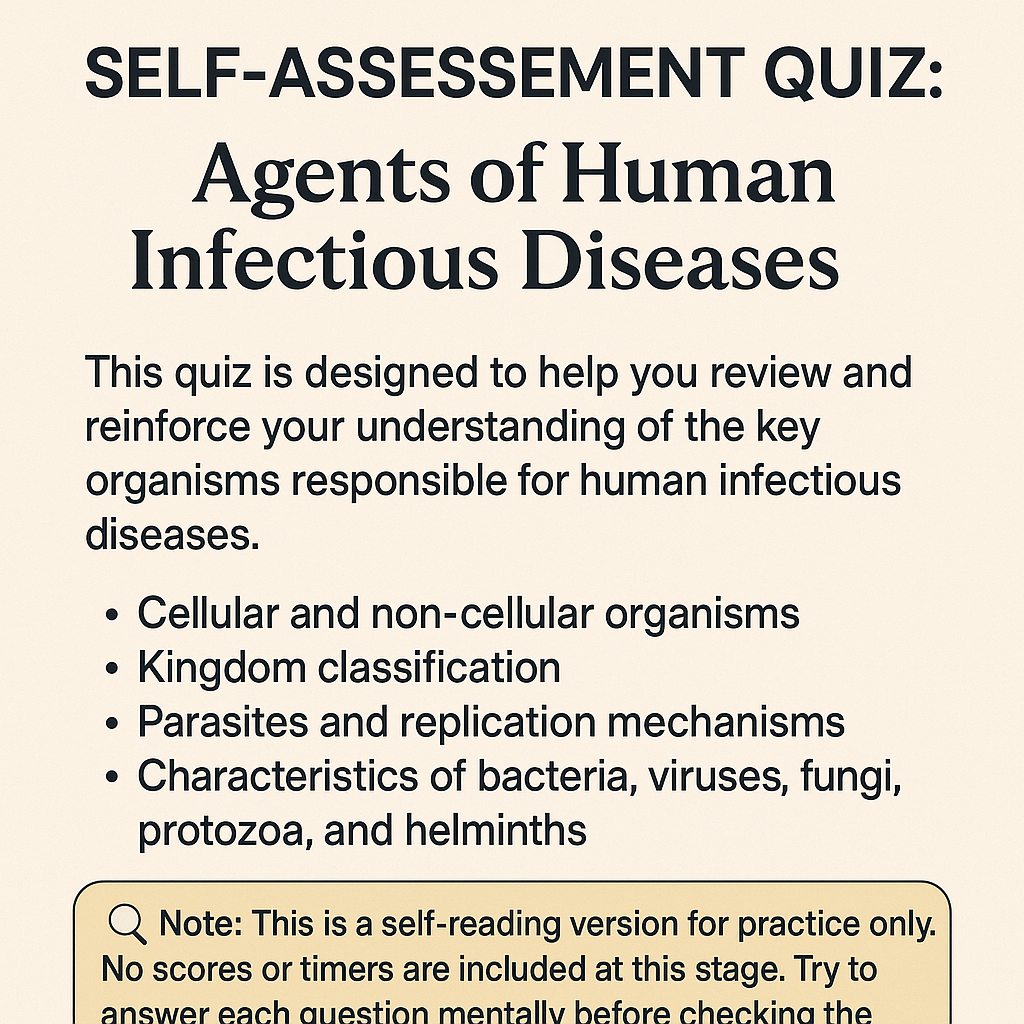Bacterial Shape, Size & Structure Quiz
Q101: Plasmids replicate independently of:
A. Mitochondria
B. Chromosomal DNA
C. RNA polymerase
D. Ribosomes
A. Mitochondria
B. Chromosomal DNA
C. RNA polymerase
D. Ribosomes
Hint: They replicate independently from the bacterial chromosome.
Q102: Which bacteria types can contain plasmids?
A. Gram-positive
B. Gram-negative
C. Both A and B
D. Only anaerobic
A. Gram-positive
B. Gram-negative
C. Both A and B
D. Only anaerobic
Hint: Plasmids occur in both Gram-positive and Gram-negative bacteria.
Q103: Which of the following is a large plasmid that can be transferred during conjugation?
A. Nontransmissible
B. Conjugative
C. Silent
D. None of the above
A. Nontransmissible
B. Conjugative
C. Silent
D. None of the above
Hint: Transmissible plasmids are transferred by conjugation.
Q104: Plasmids coding antibiotic resistance usually encode:
A. Structural proteins
B. Enzymes
C. tRNA
D. Hormones
A. Structural proteins
B. Enzymes
C. tRNA
D. Hormones
Hint: Resistance is mediated by enzymes encoded on plasmids.
Q105: Colicins are an example of:
A. Enzymes
B. Bacteriocins
C. Ribosomes
D. Exotoxins
A. Enzymes
B. Bacteriocins
C. Ribosomes
D. Exotoxins
Hint: Colicins are toxic proteins that act against other bacteria.
Q106: Which bacteria produce pyocins?
A. Escherichia coli
B. Pseudomonas aeruginosa
C. Streptococcus
D. Salmonella
A. Escherichia coli
B. Pseudomonas aeruginosa
C. Streptococcus
D. Salmonella
Hint: Pyocins are produced by Pseudomonas aeruginosa.
Q107: Which is not a function of plasmids?
A. Protein synthesis
B. Antibiotic resistance
C. Toxin production
D. Heavy metal resistance
A. Protein synthesis
B. Antibiotic resistance
C. Toxin production
D. Heavy metal resistance
Hint: Protein synthesis is the job of ribosomes, not plasmids.
Q108: Plasmids carry genes for resistance to:
A. Antibiotics
B. Heavy metals
C. UV light
D. All of the above
A. Antibiotics
B. Heavy metals
C. UV light
D. All of the above
Hint: Plasmids often carry multiple resistance traits.
Q109: What is the size of nontransmissible plasmids?
A. 100–200 million
B. 3–20 million
C. 40–100 million
D. Less than 1 million
A. 100–200 million
B. 3–20 million
C. 40–100 million
D. Less than 1 million
Hint: These small plasmids are not capable of conjugation.
Q110: Which plasmid product aids bacterial attachment to cells?
A. Flagella
B. Capsule
C. Fimbriae (pili)
D. Teichoic acid
A. Flagella
B. Capsule
C. Fimbriae (pili)
D. Teichoic acid
Hint: Pili mediate attachment to host cells.
✅ Answer Key:
Q101: B. Chromosomal DNA Q102: C. Both A and B Q103: B. Conjugative Q104: B. Enzymes Q105: B. Bacteriocins Q106: B. Pseudomonas aeruginosa Q107: A. Protein synthesis Q108: D. All of the above Q109: B. 3–20 million Q110: C. Fimbriae (pili)
